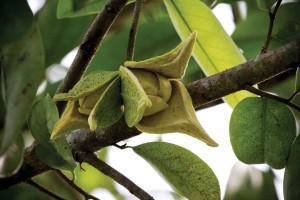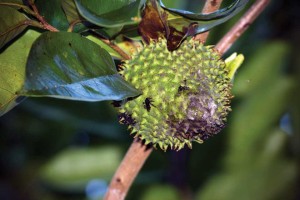Chirimoya Edible Fruits
Edible Fruits of the Mayan Diet
As people around the world expand their health consciousness, they are eager to learn more about the vast array of fruits and vegetables available to them. And, especially for local people, living in rural areas with limited incomes, it is possible to eat healthy foods, in particular fruits and vegetables. One aspect of FLAAR’s research is to find out all the healthful fruits and vegetables that have been available in Guatemala since the time of the Classic Maya.
We are also interested in understanding how these Classic Maya could feed the substantial populations of their ancient cities in areas that are semi-abandoned rainforests or low-populated mountain areas today. We are learning that Maya families would tend to have a fruit garden around their houses. So we are making lists of which species and studying its nutritional benefits.
Most people, even today, have a wide variety of tropical trees in their home gardens — these trees provide a different fruit every month or so. There are a lot of tropical trees that might have been introduced by the Maya into the traditional agriculture practice nowadays.
The annonna squamosa; its Spanish name is chirimoya. The English name is sugar apple or sweetsop. The Mayan name is tsalmuy, and the Nahual name is poshte.
One of these tropical trees cultivated around houses is the anona. There are many trees called anona in Spanish and English. For this article we selected one of these. The scientific name is spelled with two n’s; the popular name with one.
Almost everybody in Guatemala has eaten a guanaba or an anona at least once in his or her life. There is one species that we are interested in right now—the annonna squamosa; its Spanish name is chirimoya. The English name is sugar apple or sweetsop. The Mayan name is tsalmuy, and the Nahual name is poshte.
This fruit has a heart shape, with green to gray color. Even though the tree is believed to be originally from the north part of the Andes in South America, it was widely planted in Central America, especially among the Mayan lands. To this day, many people plant this tropical tree in their home gardens.
Sugar apple, another of the annona species, is used as a food supplement and medicinal plant. The edible part is the pulp in the fruit. The pulp has a white color, with a creamy texture and a sweet taste.
Its leaves are also used. It is said that when you put the leaves in the children’s baths, it calms skin irritation. Studies carried out since 2003 have been trying to determine if the leaves of the sugar apple have an antidiabetic compound and whether the compound could be used to produce medicine to treat this disease.
Since this tree grows in a wide range of altitudes, and thus is distributed throughout almost every part of the country, we have seen it a lot in family garden plots. Not only does it produce edible fruit, it apparently is used for medicinal purposes.
That is why we at FLAAR like to visit these places and show our web visitors about life outside of the city, and how people today have inherited house-side agricultural traditions.
Dr. Nicholas M. Hellmuth is director of FLAAR Reports (Foundation for Latin American Anthropological Research). For a bibliography from this article and other information, you may contact Dr. Hellmuth and his staff by email: FrontDesk@FLAAR.org

